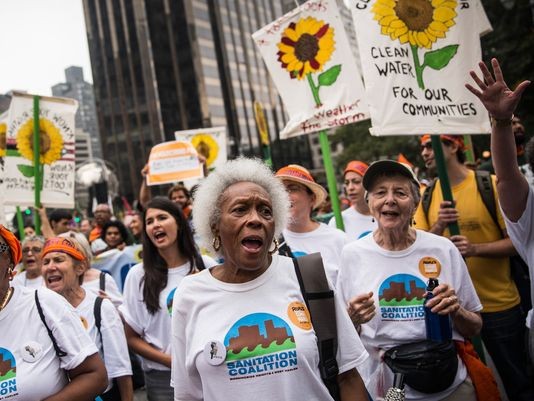(VOVworld) – The UN Climate Summit opens in New York on September 23 with the participation of 120 state leaders and representatives of thousands of global groups and financial and social organizations. As the biggest ever conference on climate change, the summit is expected to reach a binding agreement which will keep governments on track toward the signing of a climate change prevention agreement in 2015.

Sunday's march in New York, which called for drastic political and economic changes to slow global warming, was organized by a coalition of unions, activists, politicians and scientists.(Photo: Andrew Burton, Getty Images)
|
The UN Climate Summit 2014 in New York is the biggest international event on climate change since the Copenhagen Conference in 2009. Scientific, environmental, and economic research indicates that the world must invest in the fight against climate change now or the world will face dire immeasurable consequences in the next 15 years. The New York Summit aims to build a framework for negotiating an agreement to reduce greenhouse gas emissions in Peru late this year and France next year, replacing the expired Kyoto Protocol.
The global price of not working together
The World Bank reports that economic losses caused by natural disasters over the last decade are estimated at 200 billion USD annually. All nations have to bear the consequences. Storms and floods have intensified and the earth is getting warmer. The latest report by British scientists says huge iceberg the size of New York’s Manhattan Island has broken off from the Antarctic.
Despite the near certainty of future disasters, countries’ commitments in recent years have amounted to empty promises. Previous UN Climate Summits saw little beyond developed and developing countries arguing about greenhouse gas reductions, financial contributions, and technology transfer.
Copenhagen Conference 2009 had the participation of 100 world leaders, but it failed because of a lack of corporate cooperation. The tears of the head of the Filipino delegation at the UN conference in Poland in 2013 when he talked about his countrymen suffering from the Haiyan typhoon moved people but lead to no effective action. His 12-day hunger strike and appeal to the world to act before it is too late swayed many delegates but could not persuade the whole world to work together.
From determination to action: a wide gap
Although climate change has been conceded to be a global problem, countries cannot reach a common stance to address it.
Responsibility, obligations, and rights must be shared among countries. That idea has been echoed at every conference, but there has been no solution to turn determination into action.
The public is waiting for a detailed plan to solve the world’s current problems from this year’s conference. More than 600,000 people demonstrated at more than 2,000 places in 161 countries to urge action against climate change.
Working together for the future
Researchers say the next 15 years are critical for switching from fossil fuels to green energy. The world will need to invest 90 trillion USD in three sectors – green energy, low-carbon cities, and efficient use of land. If there is no change, air pollution will consume 4.4% of global GDP, damage people’s health, and increase healthcare costs.
To enjoy a better life and economic growth, we need to protect the environment and reduce emissions. Achieving economic growth, generating jobs, and reducing poverty while combating climate change will be a difficult task. But if all countries work together and minimize their individual economic interests, advanced technology and global economic restructuring can ensure a low carbon but stable growth economy.